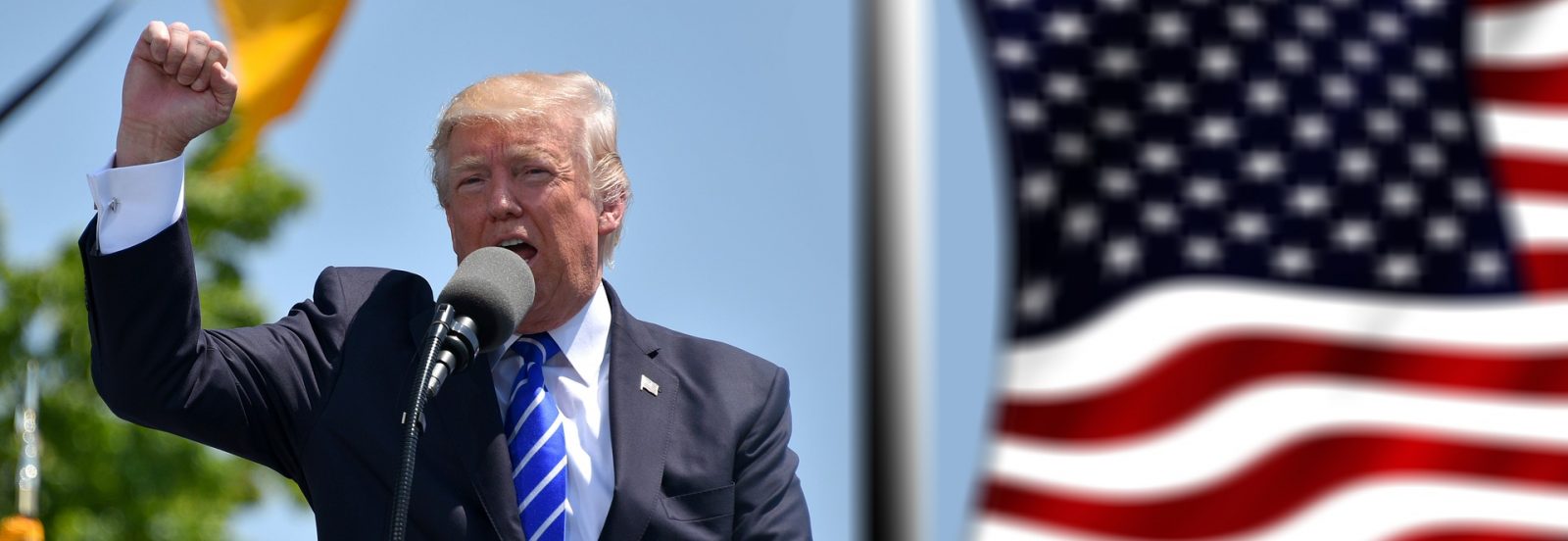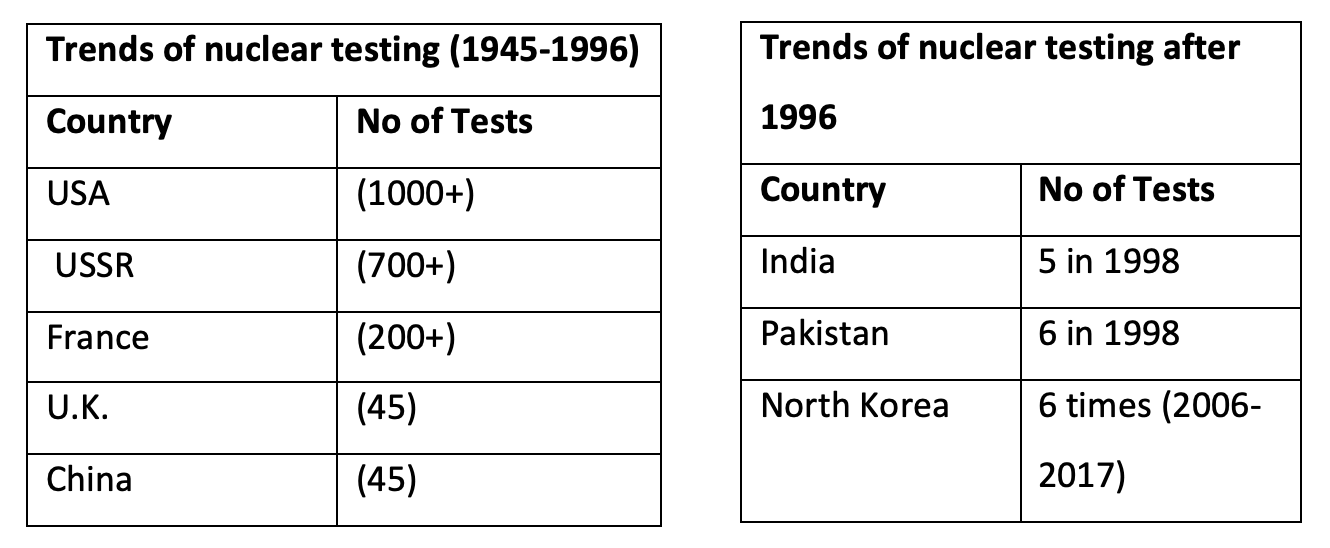 The CTBT is a binding, yet not an in effect treaty, formulated in 1996. It imposes a moratorium on all nuclear testing for either military or civilian motives. The treaty has not entered into force since it requires the ratification of 44 members with nuclear capabilities (at the time it was negotiated). The Democratic People’s Republic of Korea (DPRK), India, and Pakistan have not signed this agreement, whereas China, Egypt, Iran, Israel, and the United States have signed but not ratified it. The treaty needs the ratification of these eight countries for its full implementation.
The CTBT is a binding, yet not an in effect treaty, formulated in 1996. It imposes a moratorium on all nuclear testing for either military or civilian motives. The treaty has not entered into force since it requires the ratification of 44 members with nuclear capabilities (at the time it was negotiated). The Democratic People’s Republic of Korea (DPRK), India, and Pakistan have not signed this agreement, whereas China, Egypt, Iran, Israel, and the United States have signed but not ratified it. The treaty needs the ratification of these eight countries for its full implementation.
The U.S. Senate declined ratification of the CTBT in 1999. President Obama announced that he would intensify efforts towards its ratification, but the issue was not brought before the Senate over the expectation that it would be voted down since the Democratic Party did not have the required majority.
Allegations of Non-Compliance
In a recent gathering at the Hudson Institute in Washington, Lt General Robert Ashley, the Director of the U.S. Defense Intelligence Agency (DIA), accused Russia of covertly testing low yield nuclear weapons, which is contrary to the obligations of the CTBT. Ashley stated, “Russia’s development of new warhead designs and overall stockpile management efforts have been enhanced by its approach to nuclear testing. The United States believes that Russia probably is not adhering to its nuclear testing moratorium in a manner consistent with the ‘zero-yield’ standard”.
No evidence was provided by Ashley to support his statement. When the moderator asked him to elaborate and further clarify his stance, Ashley only pointed out that DIA intelligence indicates that the Russian Novaya Zemlya nuclear testing facility has the capacity to operate in something other than zero yields. On the contrary, according to Time Magazine, a senior U.S. intelligence official later clarified there was no consensus in the intelligence community regarding the conduction of a low yield test by Russia, but that it is assembling the facilities necessary to do so.
Despite the fact that the CTBT has not entered into force, many signatories including the U.S. and Russia, have established an international monitoring system to detect very low yield explosions. The verification regime is equipped with 300 monitoring stations deployed around the world. In response to Ashley’s statement, the Head of the CTBT has issued a statement saying, “The CTBTO’s International Monitoring System (IMS) is operating as normal and has not detected any unusual event”. The statement also reasserted that the full implementations require the treaty to be in effect; legally binding for all through effective site verifications and visits on short notice.
This gives rise to the question that if seismic readings have not signalled defiance by Russia, what compelled the U.S. to point towards Russia for a possible non-compliance of the CTBT?
On 13th June, the remarks passed by General Ashley were reasserted in the statement issued by the DIA: “The U.S. government, including the Intelligence Community, has assessed that Russia has conducted nuclear weapons tests that have created nuclear yield”.
John Bolton and the CTBT
John Mearsheimer rightly points out that President Trump has illiberal tendencies and embraces a cynical approach towards international institutions and agreements. Likewise, there are many in Washington, such as National Security Adviser John Bolton, who are quite contemptuous of multilateralism and international agreements. Speaking on the CTBT, Bolton has used remarks such as “illusionary protections of unenforceable treaties”. Moreover, in his article for the New York Times in 2009, Bolton staunchly asserts that arms control agreements are more advantageous to Russia then they are for the U.S. According to him, arms control agreements fracture U.S. defensive and offensive strategic capacities, and he opposed President Obama’s efforts to push for ratification of the CTBT.
Consequently, there is a likelihood that he is attempting to influence Donald Trump to do away with this treaty, just like the Joint Comprehensive Plan of Action (JCPOA) and the Intermediate-range Nuclear Forces Treaty (INF).
Michael Krepon, in his article, ‘Taking aim at the Comprehensive Test Ban Treaty’, has highlighted a very interesting aspect. Krepon has stated that even though it is yet uncertain whether John Bolton is involved in the assessments made by the DIA or not, there is a dire need to probe any “Intelligence Fixing” in the respective case, keeping in mind his role in fabricating intelligence for erecting a case to wage war against Iraq. Since Bolton has a track record of sifting intelligence that makes it to the White House, the possibility of the same manipulation being repeated cannot be ruled out in the DIA findings.
Russian Response
The Russian Foreign Ministry has dismissed the allegations of Russia violating the CTBT and stated, “All these accusations are completely groundless. They cannot be regarded as anything other than an attempt to justify Washington’s preparations to withdraw from the CTBT and to resume full-scale nuclear tests”. Similarly, the Ministry also conveyed that it anticipates further such allegations by the U.S. in an attempt to renounce the CTBT, repeating the same steps which were taken to abandon the INF.
Russia has also reaffirmed that it has abided by the terms of the CTBT and has forestalled nuclear testing since 1991.
Implications
On 5th August 1963, President John F Kennedy secured the Partial Test Ban Treaty (PTBT), banning nuclear testing in the atmosphere, space and under water. Kennedy considered this agreement the greatest achievement of his presidency since it minimized tensions with the Soviet Union and at the same time averted the prospects of future testing in the respective avenues. Indeed, the PTBT was the initial step towards arms control; however, the CTBT can serve as the potential framework to further cement endeavours towards of the NPT.
President Trump won’t confront the challenge that his predecessor had to face, with respect to the ratification of the treaty, since the Republican Party is in the majority in the Senate and the Democrats will surely join in voting it through. However, the Nuclear Posture Review 2018 indicates that this will not be pursued by the Trump Administration.
When critics of the CTBT raise the issue that the modernization/upgradation of stockpiles alters their nature and therefore, testing becomes mandatory, they tend to overlook the core aim of the NPT. If the constant improvement of nuclear weapons is not terminated by states, then proliferation would be difficult to control.
The following data can be used to get a basic overview of the role the CTBT has played in helping restrict nuclear testing.

John Bolton and those of like mind are indeed misguiding the White House. Deserting an arms control agreement on the assumption that Russia is not complying with it is highly erroneous. Moreover, the inference that Russia “might be” violating the obligations of the CTBT is not concrete enough grounds to let go of such a significant framework. Even if Russia is violating the terms, it should be engaged in a constructive dialogue and on-site verifications should be conducted, which will only be feasible when the U.S. ratifies the CTBT.
The U.S. can streamline this process by taking the monumental step of ratifying the CTBT. This action can pave the way where cooperation between nuclear giants can be observed. Moreover, this scenario can potentially lead towards Chinese ratification of the CTBT. Consequently, these three major powers can coordinate and toughen mechanisms to curtail any act of defiance by other states. This cooperation (coupled with positive incentives) can underpin diplomatic measures to convince North Korea to ratify the CTBT and relinquish nuclear testing.Ergo, the CTBT, despite not being ratified, has been instrumental in helping cap nuclear tests for over two decades. The U.S. doing away with the CTBT would inflict more damage than good to the U.S. itself, which has been a stalwart advocate of nonproliferation. Pulling out of the treaty will not resolve the issues of proliferation, rather it will intensify them. The essential demand of the time is the reinforcement of verification regimes which can track any act of non-compliance.
Earlier in April this year, President Trump raised the prospects of a new arms control agreement with China and Russia. However, the precipitation of a new arms control agreement cannot be materialized in the remaining period the Trump Administration has in office; the actual stratagem of this is to hamper the extension of the New START agreement.
With the INF gone, the JCPOA abandoned, the Treaty on Prohibition of Nuclear Weapons rejected, no intimation of an extension of the New START, and the looming threat of relinquishing the CTBT, the Trump Administration is leaving behind a dangerous legacy. No other American President has caused this much danger to arms control in such a short period. Reversing these trends would require several years of hard work to build a global consensus, which seems difficult, in an increasingly chaotic international security environment.




Best of luck to the arms control regime with Trump being its leader. And this is the most comprehensive take I have read on the issue. Kudos to the writer.